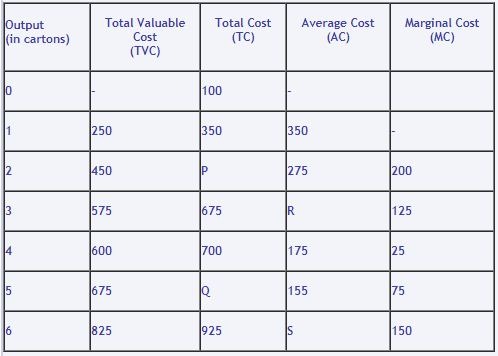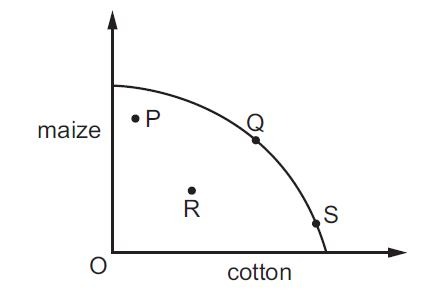2023 NECO Economics Answers for Objectives & Essay Questions Released.
Get Neco economics answers 2023 from this post. Check here for the NECO Economics 2023 questions. The National Examination Council (NECO) Economics paper for SSCE is scheduled to be written on Tuesday 1st August 2023. The Neco Economics Paper III & II (Objective & Essay) will start at 10.00 am and end by 1.00 pm.
Detailed Neco Economics 2023 answers, neco econs past questions and answers, information about the so-called neco economics expo or runz online, and also the remaining Neco timetable 2023 and its time. Continue reading.
Here, we will be posting out the Neco economics questions for candidates that will participate in the examination. Note that below is the questions from Neco past questions and answers that we feel are likely questions for Neco econs exam preparation.
NECO Economics Answers 2023.
Section II [Essay]
Answer any FIVE questions.
Write your answers on the answer booklet provided.
1. (a) What is a centrally planned economy?
(b) Outline any four features of a capitalist economy?
2. The cost function of a firm that produces plastic plates is shown in the table below. Use the information in the table to answer the questions that follow:

(a) (i) What is Average Fixed Cost (AFC)?
(ii) Calculate the average fixed cost at output levels 1 to 6.
(b) Calculate the values P, Q, R, and S.
(c) Why does the average fixed cost decline as output increases?
3. (a) What is:
(i) Peasant farming;
(ii) Commercial farming?
(b) Describe five ways in which agriculture contributes to the economic development of your country?
ANS: (a) (i) Peasant farming is small-scale farming involving the use of simple farm implements. It involves the use of small farm holdings.
(ii) Commercial farming is large-scale farming involving the use of machinery. Other forms of capital such as irrigation, improved seedling, fertilizers are also used for production.
(b) (i) Agriculture provides food and therefore reduces importation.
(ii) Agricultural exports provide foreign exchange for development.
(iii) Increased food production helps to keep down the rate of inflation.
(iv) Agriculture provides raw materials for industrial development.
(v) Agriculture provides a market for equipment and other agricultural inputs produced by the industrial sector.
4. (a) Distinguish between small-scale production and large-scale production.
(b) Describe any five internal economies of large-scale production.
ANS: (a) Small scale production is a production with a small capital outlay and therefore at a low level of output. On the other hand, large-scale production is a production with a large-scale outlay and therefore results in a high level of output.
(b) Some of the internal economies of large scale production are:
(i) Technical economies: a large firm has the advantage in the use of factor inputs which results in lower cost per unit of output.
(ii) Financial economies: a large-scale producer can borrow money from a financial institution at a lower rate because it can offer better collateral security.
(iii) Marketing economies: a large firm can buy inputs in bulk and possibly at discounts. It can also pay less on transportation and advertisement which result in lower operating cost.
(iv) Managerial economies: when output is increasing managerial cost increases at a slower rate. The number of managerial staff may increase with output. OR as output increases, specialists can be employed to take charge of the various processes e.g. marketing.
(v) Risk-bearing economies: a large firm is able to bear losses arising from its operations as it can provide insurance coverage. OR It can also diversify its product and its market.
(vi) Welfare economies: a large firm can provide better conditions of service which may enhance the level of productivity and also attract highly skilled manpower.
(vii) Research economies: a large firm can invest a huge amount in research and thereby experience technical progress.
5. (a) Differentiate between direct and indirect taxation.
(b) Highlight any five advantages of indirect taxation to developing countries.
ANS: (a) Direct taxation refers to taxes on income and properties of individuals and organizations e.g. personal income tax, and profit tax. On the other hand, indirect tax refers to taxes on goods and services e.g. excise duties, customs duties, etc.
(b) (i) In developing countries where incomes are generally low, indirect taxes yield more revenue to the government.
(ii) Where unemployment is high, indirect taxes yield more revenue.
(iii) It is cheap and easy to collect, e.g. custom duties.
(iv) It has wider coverage than direct tax.
(v) It is not easy to evade. Consumers pay as they consume the commodities.
(vi) It is not a disincentive to work.
(vii) It is used to discourage the consumption of harmful goods.
(viii) It is used to protect infant industries.
(ix) It is used to correct the balance of payments deficit.
(x) It is used to prevent dumping.
6. (a) What is the difference between the following terms?
(i) ad valorem tax and specific tax;
(ii) a progressive tax and a regressive tax.
(b) Give any three reasons why the government of your country imposes indirect taxes.
7. (a) In what two ways does agriculture contribute to the development of your country’s economy?
(b) Recommend any three measures that can be taken to boost large-scale farming in West Africa.
8. (a) What is Central Bank?
(b) Distinguish between a bank and a non-bank financial institution
(c) Outline any four contributions of financial institutions to the economic development of your country.
ANS: (a) A central bank is a government-owned bank that is responsible for formulating monetary policies of the country. It is the head of all the banking institutions in the country.
(b) Bank financial institutions are those financial institutions that receive deposits from the public and government. The deposits are repayable on demand e.g. commercial banks, while non-bank financial institutions also accept deposits from the public in one form or the other but these deposits are not repayable on demand e.g. insurance companies.
(c) (i) They invest directly in the productive sectors of the economy.
(ii) They facilitate international trade.
(iii) They provide loans.
(iv) They give financial, technical, and management advice to their customers.
(v) They help to maintain monetary stability by executing policies of the central bank.
(vi) They help to mobilize savings for investment.
9. (a) What is public debt?
(b) Explain any four reasons why countries in West Africa continue to incur debts.
10. (a) What is export promotion?
(b) Describe any four measures the government of your country can adopt to encourage production for export.
NOTE: There is nothing like Neco Economics expo online. Do not be deceived by fraudsters posing fake neco answers on the internet. Keep reading.
NECO Economics Objective Questions 2023.
1. The diagram below shows a production possibility curve for maize and cotton.

Bad weather causes a poor harvest for both crops.
Which movement could be used to represent this change?
A P to R B Q to R C S to Q D S to R.
2. The market for a good was in equilibrium. A change occurred which resulted in a new equilibrium with a higher price for the good and a lower quantity traded.
What change would have caused this?
A the demand curve moved to the left
B the demand curve moved to the right
C the supply curve moved to the left
D the supply curve moved to the right.
3. A government subsidizes the production of pineapples.
This is likely to
A increase the price of pineapples
B raises the costs of supplying pineapples
C raise revenue for the government
D causes the supply of pineapples to increase at every price.
4. What might be a disadvantage to a trade union when arguing for an increase in its members’ pay?
A an increase in imports of a cheaper, similar product
B the closure of a local training college resulting in fewer potential workers
C the development of a new and profitable brand of the company’s product
D the development of new techniques that increase productivity.
5. A Japanese car manufacturer decided to produce its cars in a factory in Europe.
What would not be a reason why they might have chosen to do this?
A cheaper wage costs in Europe
B the availability of raw materials
C to gain external economies from skilled labour in Europe
D to increase Japanese self-sufficiency.
6. A government removed the quota on goods imported into the country.
What is the most likely result of this?
A a decrease in demand for domestic production
B a decrease in domestic unemployment
C a decrease in exports
D a decrease in the balance of trade deficit.
7.
Keep following, more questions and answers will be added soon.

I almost forgot that i don’t av money for expo thanks to this site fot providing questions and
answers
Thanks
Okays
PLS TRY TO HELP ME PASS THIS NECO EXAMS VERY WELL , I REALLY NEED EXPO IN ECONOMICS , MARKETTING AND CIVIC EDUCATION.
Thanks,but is this the real questions and answers for tomorrow
Thank U Very Much
U av 2 read
Is it d one we are having 2morrow
No next year
Is this one for tomorrow….
Last year questions oh bro
Not really real self but still can help sha for people know what is doing people who dont know anything will also be angry about this they sha want expo ni
If you want to pass, you should study hard. Not messing around looking for expo
You have to work hard1⃣1⃣
Great
You guys help real good
Thanks a lot for the practice questions
I need answer for economic question
We do we have economic
Neco
IN complet
Wrong runs
Una posting us shiit abi
why do you call it shit
we really thank
I hope this is legit
But all the same thanks guys
Which department are you
Please help out
Pls is this legit
How can we get the remaining answers
Wow so lovely thanks guys
Thank you a lot you are welcome
I want to create a site
How can we get the remaining answers
Thanks is not easy alone
Thanks is note
Thanks a lot
Thanks for your helping more knowledge in jesus name amen
Thanks much
Thanks for this opportunity
pls reply me if you’ve tested this website before
Pls is this Legit?
Thank you
Pls i want to,pass my neco
If you want to pass, you should study hard. Not messing around looking for expo
You have to work hard1⃣1⃣
Can it be the real one
Thanks oooo
We really appreciate
No
Thanks a lot
Think this will really help🙋
Thanks so much
I one to past my neco
Thanks for your helping more knowledge in jesus name amen
Thanks a lot I really appreciate
Calm down o
This is not real
thanks
Thanks
Pls is it the ans for this year 2020 exam?
Thanks alot
Thanks for the help, it’s not really easy doing it alone..
I want to pass send a PDF
Thanks alot
I want to pass my neco this yr pls help me making my neco and give me expo now thank u alot
Thanks a lot
thanks
Thank you
Thank
Thanks so much
Thanks for impacting this knowledge
thank
Thanks